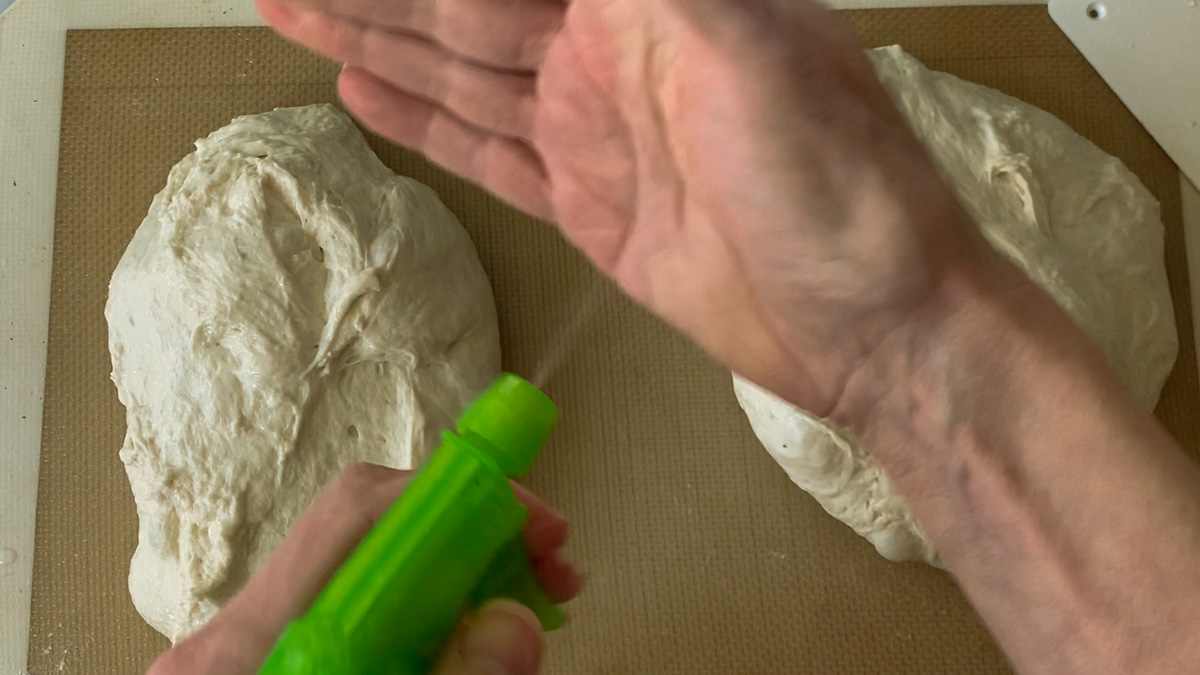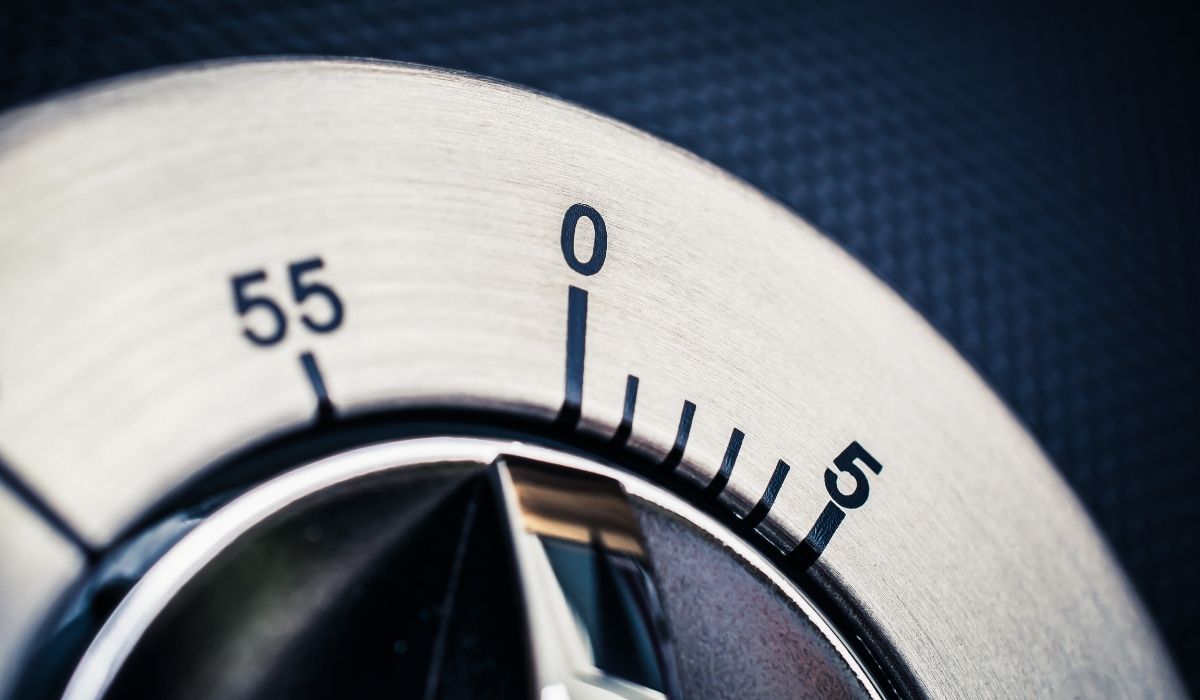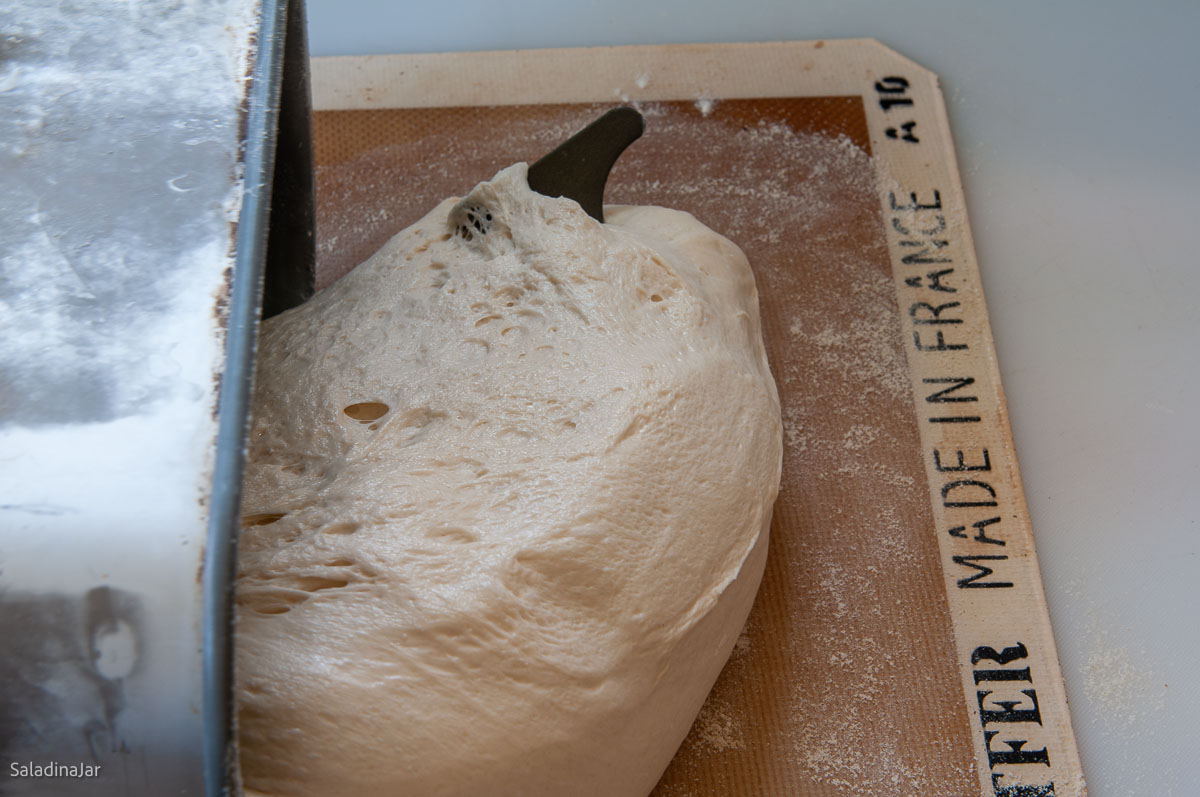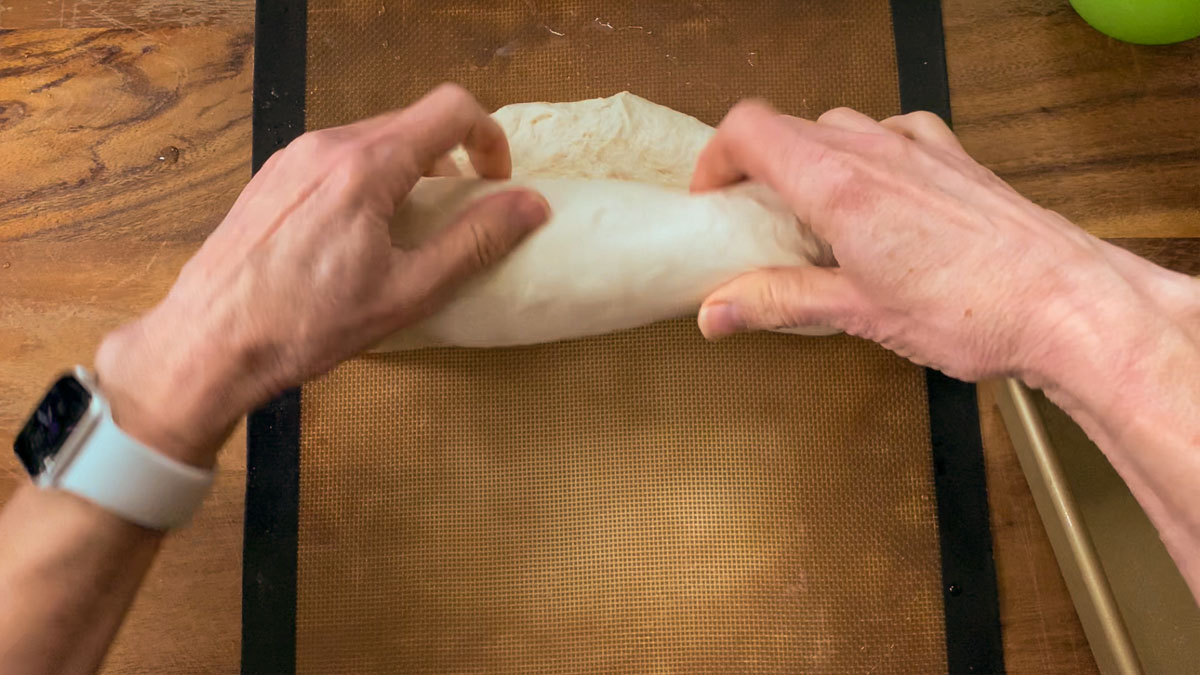Sourdough Bread Machine Bread: A Simple Loaf Good for Sandwiches
Sneak Preview: This sourdough bread machine bread recipe makes a great-tasting simple white loaf. Use a bread machine to mix it with the DOUGH cycle, then bake it in a conventional oven. Because the recipe also includes commercial yeast, you can bake this in 3½ hours.

As an Amazon Associate, I earn from qualifying purchases.
Like homemade Greek yogurt, there must be a million ways to make sourdough bread, and plenty of people are willing to tell you how. Who do you listen to? Does it have to be so complicated?
I played with sourdough starter years ago. When it turned colors, I decided it wasn’t worth the trouble or guilt, so out it went. This time around, I’m determined to keep it simple. That’s why we’re using the bread machine for this recipe.
Please note: This recipe contains instant yeast for a quicker turnaround–about 3½ hours. However, your bread still needs to cool for an additional hour. I’ll share my trick for doing that at the end.
Happy Bakers Speak Up
“Thanks Paula, another winner! I have struggled with sourdough bread recipes. This one is straightforward. It bakes up perfectly. If anyone is skeptical about trying this one, don’t be afraid of it.”–SHARON
Where Can I Get a Sourdough Starter, or How Do I Make It?
- Sourdough breadmakers love to share their starters. Keep your ear to the ground.
- You can buy dry cultures on Amazon that will require some time to rehydrate and develop. King Arthur Flour sells fresh sourdough starter.
- Make it yourself. Recipes and formulas abound on the internet. You can see my method for making a starter with yogurt whey in this post. But you don’t have to use whey in your starter as I do. Unflavored yogurt or water can be substituted for whey to get things started.

What You Can Expect from this Bread Machine Sourdough Recipe
- TASTE: The level of sourness will depend mostly on your starter. The recipe is basic. See below for a modification of this recipe to make your bread taste more sour.
- TEXTURE: As you can see by the pictures, the texture of this recipe is somewhere between finely textured regular white bread and a chewy artisan loaf with lots of big holes. If you bake this dough in a loaf pan, the texture will be soft, fairly uniform, and slightly chewy.
Free-form loaves, as seen below, are baked on a cookie sheet and tend to have the same soft texture with a few larger holes.

- CRUST: I tried to keep this recipe simple. Only a loaf pan is required, along with a pan of hot water, to create steam in your oven. A floury top adds an artisan look. Keep reading for more ways to modify the crust.
- FAT: The recipe doesn’t specify any fat. If you want a softer and less chewy crumb, add 1-½ tablespoons of softened butter or oil when adding the wet ingredients to the bread machine pan. The fat will also help to prolong freshness.
How Do I Get a Nice Crust on My Sourdough Loaf?
Because the bread is baked in a conventional oven, the crust can be manipulated with baking techniques or glazes. Here are some options:
- Bake your bread in a loaf pan. The crust will be crispy at first but soften with time. Covering the top with flour before slashing gives a professional look.
- Shape the dough into a free-form loaf and bake on a cookie sheet. The crust will come out of the oven crusty but soften within hours.
- Bake bread in a preheated Dutch oven or another covered pan for a crispy and dark finish. This method takes longer and more attention but gives your bread a bakery-made look. I won’t go into details here since this is meant to be a simple loaf suitable for beginners.
- Brush bread with a glaze of 1 egg and a teaspoon of water or milk. This treatment gives your bread a beautiful dark golden color, a shiny finish, and a crispy crust that softens to slightly chewy when cool. My favorite for this bread!
- Place a pan of boiling water into the oven on the lowest rack under your bread. In addition, spritz the bread with a mister (spray bottle) a couple of times in the first 5 minutes of baking. (Do it quickly so not much heat will escape the oven.) This will make a crusty finish that comes close to using a Dutch oven.
Ingredients and Substitutions

- STARTER: Hopefully, you already have a starter. When you are ready to mix up your bread, it should be spongy and bubbly. Even if your starter is not as robust as you would like, you can still use it in this recipe since bread machine yeast is included.
- Measuring the starter can be tricky. For my recipes, I recommend a digital scale. Without scales, stir down the starter and use a measuring cup.
- The starter I make and use has 100% hydration. Whenever feeding my starter, I use equal weights of flour and water. For example, for every 1 cup of flour (120 gr), add 1/2 cup of water (120 gr). If your starter is different, no problem. With a bread machine, you can easily adjust the dough after a quick peek inside.
- Watching your machine as it kneads is more important than ever when baking with a sourdough starter. Open the lid and look to see if your dough needs more liquid or flour after the dough has been kneading for about 15 minutes.
- The goal is for the dough to be tacky, stick to the sides as it kneads, then pull away cleanly. (See video.) If it’s too wet, add more flour; if too dry, add more water. Add only 1 tablespoon at a time and wait for the dough to absorb it completely before adding more.
- WATER: I use tap water left sitting on the kitchen counter without a lid for 24 hours. This allows the chlorine to evaporate.
- SUGAR: I use granulated sugar. You could leave it out, but it helps the bread rise and improves the flavor. Substitute honey if you prefer.
- SALT: Use table salt or sea salt. I prefer sea salt because no iodine is added. If you only have Kosher salt, add an additional ¼ teaspoon.
- You can experiment with lesser amounts if you try to cut back on salt. But don’t cut it out completely.
- Salt and yeast work together. Without it, yeast will go crazy and act like a teenager without rules. Just when you need them the most, the yeasty bodies will be sleeping because they’ve exhausted themselves unnecessarily and won’t do their job.
- FLOUR: This recipe specifies bread flour, but unbleached all-purpose flour works, too. You might try half bread flour and half all-purpose. Experiment to see what you like better.
- If you want to add whole wheat flour, replace two tablespoons of bread flour with two tablespoons of wheat flour to start with. Adding too much whole wheat will make your loaf dense.
- YEAST: Use bread machine yeast, instant yeast, or rapid-rise yeast in bread machine recipes. They’re interchangeable. If you only have active dry yeast on hand, you can use it (even without dissolving), but it may work a little slower. Allow extra time for proofing, or add an extra ¼ teaspoon.

FAQ About Sourdough Bread in a Bread Machine
Look for lots of bubbles on top and a spongy texture throughout. A glass jar or bowl makes it easier to observe. The smell should be yeasty, like the smell of a beer factory.
The sourdough starter will soon be running out of your ears unless you make bread daily. Think about the sourdough starter as a tiny bubble machine. Want bubbles? Give it fuel. Once the bubble machine has blazed through the food, the starter won’t make more bubbles even though the starter still tastes good.
You don’t have to throw it away. Instead, save discard in a separate jar in the fridge to use later for sourdough discard recipes. Discard is only good for about one week before the taste becomes too sour.
Sourdough bread recipes without yeast take a LONG time to rise. Most bread machines aren’t set up for that amount of waiting, so they must have additional yeast. Take a look at this sourdough bread machine recipe with no yeast. It will yield a traditional-looking and tasting sourdough loaf that you can mix with a bread machine.
You can try, but baking in the machine will require some compromises. The crust, texture, and appearance won’t be the same. A bread machine only heats to around 300˚F. The crust tends to be more like cardboard and rather tough at that temperature.
Perhaps the dough was too dry (did you measure your flour accurately?), the ambient temperature was too cool (throw a blanket over your machine), or the bread didn’t have enough time to rise before baking whether you baked in your oven or tried to do it in the machine. It’s also possible that your starter wasn’t ready to use when you added it to your bread.
Baker’s Secrets
1. Jumpstart a cold sourdough starter with a bowl of warm water.
Set your jar or bowl of starter inside a bowl of warm water before feeding it. If your starter is active, it will be bubbling in no time.
2. It is unnecessary to heat the water (or any other ingredients) when using a bread machine.
As long as they aren’t icy cold, the ingredients will be heated quickly by the friction caused by the paddles in your bread machine.
3. When shaping the dough for a loaf, use your fingers to gently press out any big bubbles.
Please pay attention to the perimeter of your dough rectangle before rolling it into a cylinder shape. Failure to press out the giant bubbles can result in tunnels inside the bread that look the same as when a mole visits your yard.
4. Instead of flour, use a spray bottle of water to wet the surface before shaping your dough.

Also, spray your hands and bench scraper. Damp hands will help keep your dough light. Water works much better than flour with sticky dough. You can also use spray-olive oil instead of water for extra flavor–especially good with sandwich bread.
5. Use a silicone baking mat as a work surface for shaping the dough.

- Easy to wash by hand or throw into the dishwasher.
- Silicone mats are inherently non-stick. They won’t absorb water or oil and use less bread flour than working on a countertop.
- When appropriate, shape the dough and leave it on the mat. Transfer the mat holding the bread onto a baking sheet and straight into a hot oven. Wipe any excess flour from the mat so it won’t burn as the bread bakes.
- When baking bread that might leak (cheese bread or something with fruit), a mat on the baking sheet is much easier to clean than a baking sheet with burned-on cheese or fruit.
6. Allow sourdough bread to cool completely before slicing into it.

Sourdough bread needs at least one hour to cool and finish the baking process. If cut while still warm, your bread will be gummy.
Read this post for more tips for using a bread machine in general.
How To Mix Sourdough Bread in a Bread Machine with the DOUGH cycle



How To Shape the Dough and Bake It in the Oven



Doing it this way creates a beautiful texture when you cut it open that you won’t get when baking in a bread machine. (Look at the first picture to see how the texture swirls instead of a random crumb pattern.)




Place the bread on a cooling rack for at least an hour before cutting. Keep any leftovers in a plastic bag (this one is especially sized for bread). Do not refrigerate. Freezing for a short time is fine. Double-wrap so it won’t dry out.
Parting thoughts: You know that part about letting your loaf cool for a minimum of one hour or even longer? That is so hard for me. So here’s my little trick: I consciously plan to run an errand that requires me to leave the house or go for a walk for at least an hour until that loaf is cool.
Please tell me I’m not the only one who uses these kinds of silly tricks in my life.
Not sure you want to mess with sourdough? This Condensed Milk Bread is one of the best. Or try this Honey Wheat Bread Machine Bread if whole grains are your thing.
More Bread Machine Recipes
- 69+ Best Bread Machine Recipes To Make You Look Like a Pro
- A Crusty Bread Machine French Bread
- Bread Machine Sourdough Dinner Roll Recipe
- Bread Machine Sourdough Bread Recipe – No Yeast
Help at Your Fingertips: For questions or suggestions, email Paula at saladinajar.com. If you need help, I’m happy to troubleshoot via email (faster than leaving a comment). Attach pictures and as many details as possible for the best advice.

Sourdough Bread Machine Bread: A Simple Loaf Recipe
Rate this recipe
(5 stars if you loved it)
Video
Ingredients
- 1 cup (227 g) water
- ⅓ cup (80 g) sourdough starter
- 1½ teaspoon table or sea salt
- 1½ teaspoon granulated sugar
- 3 cups (360 g) bread flour
- 1½ teaspoons instant or bread machine yeast
Instructions
- Add all ingredients in the order given: 1 cup (227 g) water, ⅓ cup (80 g) sourdough starter, 1½ teaspoon table or sea salt, 1½ teaspoon granulated sugar, 3 cups (360 g) bread flour, and 1½ teaspoons instant or bread machine yeast.
- Choose the DOUGH cycle and hit START.
- 15 minutes into the DOUGH cycle, lift the lid and check the dough. It should be tacky enough to stick to the sides of the pan, then pull away cleanly. If too wet, add flour 1 tablespoon at a time. If too dry, add water 1 tablespoon at a time. Give the machine 2-3 minutes to knead in the flour or water before adding more.
- When the DOUGH cycle is complete, check the dough. It should be double the original size. If it has not risen enough, leave it in the machine until it does.
- Remove the dough onto a floured or wet surface I keep a spray bottle handy. Press the dough into a rough rectangle. The short side should be slightly wider than the length of your bread pan.
- To make a loaf, roll the dough into a cylinder starting from the short side. Seal the seams and turn the ends under and pinch shut.
- Place dough with the seam down into a greased 9 x 5-inch loaf pan. The dough should not fill the pan more than half full. If the pan is too full, use a larger pan or pull out some of the dough and make rolls with the extra dough.
- Set the prepared loaf in a warm place, cover, and allow to rise again until approximately one inch above the top of the pan.
- Meanwhile, Preheat your oven to 450˚F (230˚C).
- When your loaf is ready to bake, sprinkle the top with flour. Make slashes diagonally or one slash lengthwise down the middle.
- For a crispier crust :(optional), place a pan containing 2 cups of boiling water onto the bottom rack of your oven while the bread bakes. Spritz loaf lightly with water a couple of times in the first five minutes to add steam.
- Place bread in the oven and turn the oven temperature back to 425˚ for 25-30 minutes. The loaf is done when the internal temperature reaches 200-210˚F.
- After ten minutes, remove baked bread from the pan onto a cooling rack so the bottom won’t steam and get soft.
- Allow your bread to cool at least one full hour before cutting into it. Failure to wait will cause the bread to be gummy.
Notes
- The day before you want to serve the bread: Combine all of the water, sourdough starter, and half of the bread flour in the bread machine pan. Start the machine and let it mix just until all the flour is moistened. Turn the machine off. Let this mixture sit until you are ready to make bread the next day.
- Making the bread: Add the salt, sugar, remaining flour, and yeast. Mix on the DOUGH cycle. Proceed to Step 4 and finish making the bread as directed.
Equipment
Nutrition
All images and text ©️ Paula Rhodes for Salad in a Jar.com



Paula Rhodes, owner
As a retired home economist, I created Saladinajar.com to share my belief that you don’t have to be a chef to find joy in creating homemade food worth sharing. Bread machines (used in an unconventional way), homemade yogurt, and quick microwave recipes are my specialty.